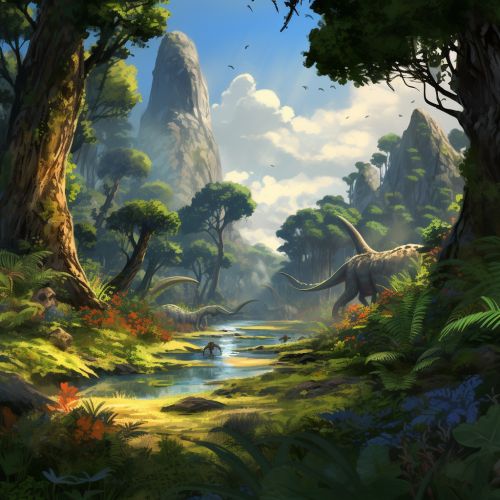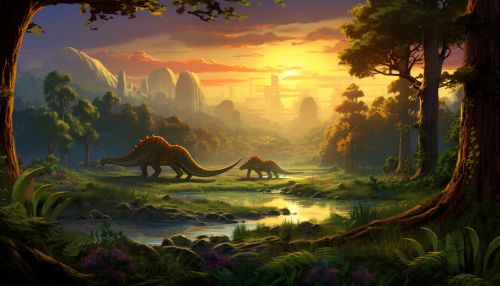Jurassic
Overview
The Jurassic period, a span of geological time from 201.3 million years ago (mya) to 145 mya, is the second segment of the Mesozoic Era, nestled between the Triassic and Cretaceous periods. This period is renowned for the proliferation of dinosaurs and the advent of birds, marking a significant shift in the planet's biodiversity.


Geology
The Jurassic period is characterized by significant geological events, including the breakup of the supercontinent Pangaea, leading to the formation of the modern continents. The period also saw the opening of the Atlantic Ocean, which had profound effects on global climate and sea levels.
Tectonic Activity
The Jurassic period was a time of intense tectonic activity, with the breakup of Pangaea into two major landmasses: Laurasia in the north and Gondwana in the south. This tectonic activity led to the creation of the Atlantic Ocean, dramatically altering the Earth's geography.
Climate
The Jurassic climate was generally warm and humid, with no polar ice caps. This climate facilitated the proliferation of lush vegetation, which in turn supported the large herbivorous dinosaurs that dominated the period.
Flora
The Jurassic period was a time of significant evolution in plant life. The flora of this period was dominated by gymnosperms, including conifers and cycads. The first angiosperms, or flowering plants, also appeared during the late Jurassic, marking a significant evolutionary milestone.
Fauna
The Jurassic period is most famous for its diverse and abundant dinosaur fauna. Dinosaurs became the dominant terrestrial vertebrates after the end-Triassic extinction event, and they continued to diversify into a variety of forms throughout the Jurassic.
Dinosaurs
The Jurassic period saw the rise of many iconic dinosaur groups, including the long-necked, long-tailed sauropods and the bipedal, carnivorous theropods. The period also saw the evolution of the first birds from theropod ancestors, marking a significant evolutionary transition.
Marine Life
The Jurassic seas were teeming with life, including large marine reptiles such as ichthyosaurs, plesiosaurs, and pliosaurs. The period also saw the rise of ammonites, shelled cephalopods that are often used as index fossils for the Jurassic.
Invertebrates
Invertebrates flourished during the Jurassic period, with a diverse array of insects, spiders, and other arthropods. The period also saw the rise of the first true beetles, which would go on to become one of the most diverse groups of organisms on the planet.
End of the Jurassic
The Jurassic period ended with a minor extinction event, which led to the decline of several dinosaur groups. This event set the stage for the rise of new dinosaur groups in the ensuing Cretaceous period.
